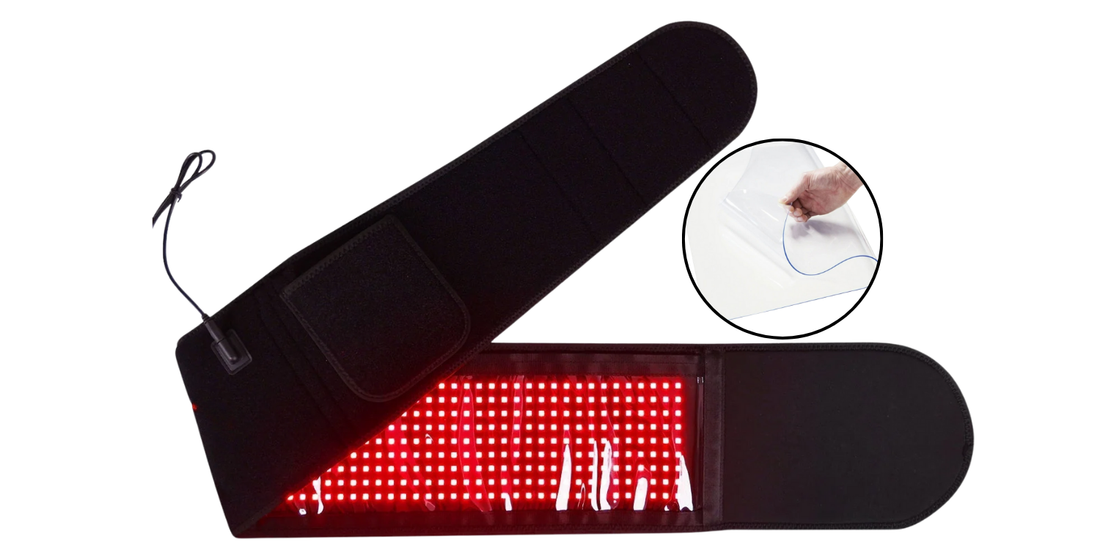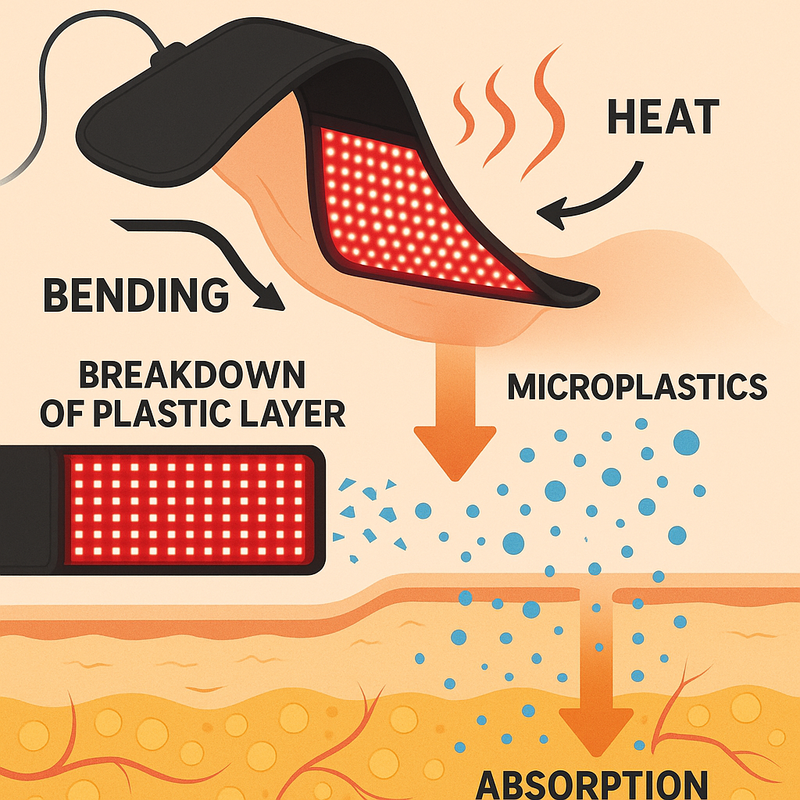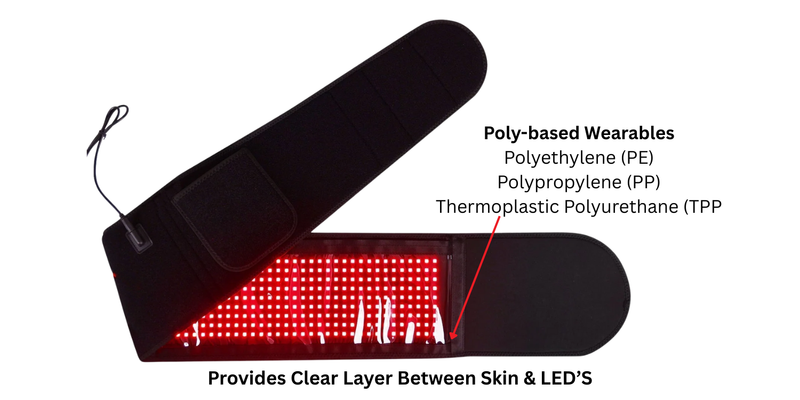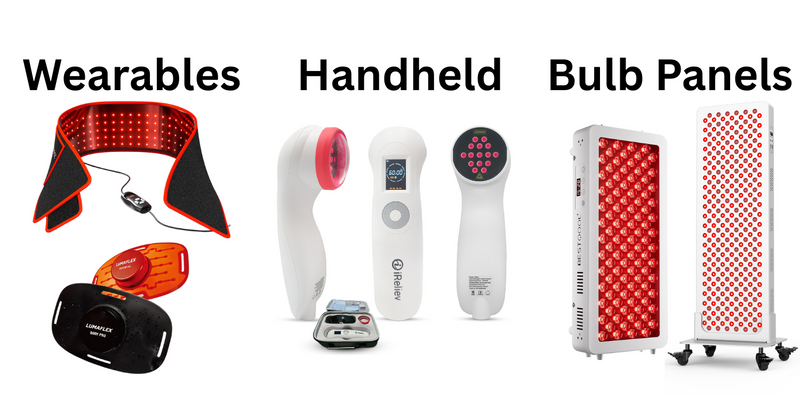
The Hidden Risks and Breakthroughs in Red Light Therapy Wearables
Key Takeaways
- Red light therapy wearables are reshaping the category thanks to LEDs: less heat, lower EMF, affordability, and flexible designs.
- Most wearables use polymer sheets (PE, PP, TPU) to cover LEDs, but these degrade into microplastics with heat, bending, and UV exposure.
- Microplastics can be absorbed through sweat, pores, and micro-abrasions — potentially worsening inflammation.
- Medical-grade silicone offers a safer, more durable, biocompatible solution that allows light to pass while protecting LEDs.
- Wearables also outperform panels and handhelds in irradiance efficiency, since they’re always in direct skin contact.
- Medical-grade silicone red light therapy wearables provide a safer, more effective alternative to traditional polymer-based devices.
Materials Used in Red Light Therapy Wearables
Red Light Therapy (RLT) has exploded in popularity — from gyms and recovery centers to home wellness setups. And while red light therapy wearables (belts, wraps, mats, chairs) have made it easier than ever to bring this technology into daily life, not all devices are created equal.
Behind the marketing claims of “healing,” “pain relief,” and “recovery,” there’s an overlooked issue in how most wearables are designed and built — and it comes down to the materials used right next to your skin.
Why Red Light Therapy Wearables Are Changing the Game
The shift from bulky bulbs and panels to LED-powered red light therapy wearables has reshaped the category:
- Lower Heat → LEDs emit less heat than traditional bulbs, making them safer for long sessions and daily use.
- Lower EMF → LEDs naturally reduce electromagnetic field (EMF) exposure compared to large panel systems.
- Affordable & Compact → LEDs are cheaper to produce and can be engineered into low-profile, flexible designs.
- Closer Contact → Wearables sit directly on the skin, ensuring light penetrates where it’s needed most. Unlike panels or handhelds (which often require being within 6 inches to work effectively), wearables maximize absorption through direct skin contact.
This is why wearables are quickly becoming the preferred choice for recovery, pain relief, and performance. But there’s a catch.
The Microplastic Problem in Red Light Therapy Wearables

Why Do Plastics Break Down?

Most red light therapy wearables (belts, wraps, mats, chairs) use a polymer sheet — typically polyethylene (PE), polypropylene (PP), or thermoplastic polyurethane (TPU) — to protect the LEDs from sweat, moisture, and friction.
At first, this sounds practical. But repeated use tells a different story:
- Heat Stress → Even modest LED warmth (40–50°C) causes plastics to soften and become brittle over time.
- Mechanical Stress → Wearables bend, flex, and compress with each use — causing cracks and flakes to shed.
- UV/IR Exposure → Continuous exposure accelerates plastic degradation into smaller fragments.
- Direct Skin Contact → Because the plastic layer touches your skin, microplastic fragments can transfer into sweat, pores, or micro-abrasions.
- Cumulative Exposure → Daily use means repeated contact and long-term accumulation — exactly the opposite of what a “healing device” should do.
The irony is clear: many red light therapy wearables marketed for reducing inflammation may actually contribute to it by introducing microplastics directly onto the skin.
Comparison: Plastic-Based vs. Medical-Grade Silicone Wearables
Why Materials Matter in Red Light Therapy Wearables
The material that sits between your skin and the LED must do two things:
- Protect the LEDs from sweat and friction.
- Allow red and near-infrared light to pass through effectively.
Cheap plastics can do both, but they break down over time and pose risks.
By contrast, medical-grade silicone is:
- Biocompatible → won’t irritate skin or shed harmful particles.
- Durable → maintains strength even under repeated heat, bending, and cleaning.
- Safe for Hygiene → resists alcohol wipes and disinfectants without degradation.
- Light-Transparent → allows red and near-infrared light to penetrate effectively into skin tissue.
This is why high-quality devices — like Lumaflex — choose silicone over plastics.
Wearables vs. Panels: Why Proximity Matters

Another overlooked advantage of red light therapy wearables is irradiance efficiency.
- Panels and handhelds → To work effectively, they must be held close to the skin (within 6 inches). Too far away, and light intensity drops dramatically.
- Wearables → By being strapped directly against the body, they maximize absorption with less light loss.
This means users often get better outcomes with lower power — making wearables both effective and energy-efficient
Choose Safer Red Light Therapy Wearables
At iReliev, we believe in wearables that truly heal — not harm. That’s why we offer wearable alternatives, including the Lumaflex Essential and Lumaflex Body Pro, and Move+ by Kineon are built with medical-grade silicone, designed to last a lifetime while delivering safe, effective red light therapy.
👉 Don’t settle for plastic-based devices that risk your health. Explore the future of red light therapy wearables .





